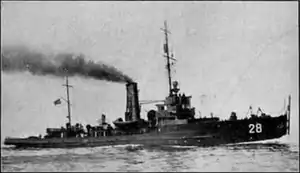IIS Shahin
Shahin (Persian: شاهین), named Pahlavi (Persian: پهلوی) from 1926 to 1935, was an Iranian naval gunboat[1][2] sunk in the World War II, having previously served in German navy during World War I as a minesweeper.
 Photo published by Jane's (1933) | |
| History | |
|---|---|
| Name: | FM24 |
| Operator: |
|
| Builder: | J. Frerichs & Co, Einswarden |
| Laid down: | 1917 |
| Launched: | 1918 |
| Commissioned: | 15 March 1919 |
| Stricken: | 29 April 1922 |
| Fate: | Sold |
| Renamed: | Fatiya (1923) |
| Homeport: | Hamburg |
| Fate: | Sold to Iran (1923) |
| Namesake: | |
| Operator: | Imperial Iranian Navy |
| In service: | 1923–1941 |
| Renamed: |
|
| Homeport: | Khorramshahr |
| Fate: |
|
| General characteristics | |
| Class and type: | FM1-class minesweeper |
| Displacement: | 135[1] or 170[2][3] tonnes |
| Length: | 132.5 ft (40 m)[1][2] |
| Beam: | 19.33 ft (6 m)[1][2] |
| Draft: | 4.0 ft (1 m)[1][2] |
| Installed power: | 800 indicated horsepower (0.60 MW)[1][2] |
| Propulsion: | 2 × Triple-expansion machinery[1][2] |
| Speed: | 16 knots (30 km/h)[1][2] |
| Complement: | 44 officers and men[1][2] |
History
FM24 was built by German Frerichs & Co. at Einswarden, near Nordenham.[4] A FM1-class minesweeper, she was launched in 1918 and was commissioned by Imperial German Navy on 15 March 1919.[4] FM24 continued to serve in the Reichsmarine until 29 April 1922,[4] having been sold on 7 April 1922 to an unknown buyer in Hamburg for M650,000.[5]
When Uzbeks attacked Persian customs and military posts stationed near Farahabad, killing the customs chief and stealing wives and belongings of the men by sea, Persian government sought to enforce its forces in the Caspian Sea.[6] Persian military procurement agent in Germany was ordered to buy a vessel,[6] and in 1923, Fatiya was purchased by Iran for a reported fee of £4,000.[1][2] The government then armed her with a 48mm canon and a 37mm heavy machine gun, and hired a skilled Persian-Armenian marine in the German service, Khachik, to bring her via Volga to Enzeli.[6]
The Soviet Union refused to let Persia pass the vessel through Volga, on the grounds that it was "inconsistent with Soviet interests".[6] Persians decided to disarm the ship and send it as a civilian ship, while sending its armaments via another route to assemble them again. However, the Russians refused entry again and offered to provide the Persian government with its own vessels to assist in fighting contraband.[6] Although the denial of the vessel was not against the Russo-Persian Treaty of Friendship (1921), it has been described as "an act of bad faith and ill will".[6]
Sobsequently, she was brought to serve in the Persian Gulf.[6] In 1926, she was renamed to Pahlavi[3] after the royal name.[6] Because it was judged to be less worthy than the name,[6] it was renamed to Shahin in 1935[3] her namesake being a bird.[6]
Shahin was reportedly broken-up in the early 1940s.[4][3] Reports indicate that she was sunk by the Royal Navy in Operation Bishop during 1941 British invasion of Iran.[7] American magazine Proceedings wrote that as of 1944, she was "no longer serviceable, her plates being rusted through and her engines in even worse case".[8]
See also
- List of minor warships of World War II
- List of World War II ships of less than 1000 tons
- List of ships of the Imperial German Navy
- Historical Iranian Navy vessels
References
- McMurtrie, Francis E., ed. (1940), "Iran", Jane's Fighting Ships, Jane's Information Group, p. 246, ASIN B0013B61EO
- McMurtrie, Francis E., ed. (1938), "Iran", Jane's Fighting Ships, Jane's Information Group, p. 256, ASIN B000C4006S
- Gardiner, Robert; Chesneau, Roger, eds. (1980). "Persia". Conway's All The World's Fighting Ships 1922–1946. London: Conway Maritime Press. p. 409. ISBN 0-85177-146-7.
- Dodson, Aidan; Cant, Serena (2020), "Ships and Fates", Spoils of War: The Fate of Enemy Fleets after the Two World Wars, Seaforth Publishing, p. 139, ISBN 9781526741998
- Gröner, Erich (2010), Alle deutschen Kriegsschiffe von 1815–1936, Salzwasser-Verlag, p. 124, ISBN 9783861953913
- Mirfendereski, Guive (2001). A Diplomatic History of the Caspian Sea. Springer. pp. 136–137. doi:10.1057/9780230107571_4. ISBN 978-0-230-10757-1.
- Schedel, Charles Jr. W. (1985), "Ask Infoser", Warship International, International Naval Research Organization, 22 (1): 101–104, JSTOR 44888943
- "Professional Notes", Naval Institute Proceedings, United States Naval Institute, 70 (494): 483, April 1944